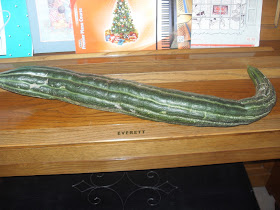The medium dark green Armenian cucumber is the melon’s version of a regular American-type cucumber. This cucumber is a C. melo and can be easily crossed with muskmelons. It is completely average in size and shape. However, it has a very nice texture, closer to the texture of a Painted Serpent cucumber than to the texture of a regular white Armenian cucumber.
The downy fuzz factor is minimal. The short hair that covers this melon is almost undetectable when sliced, but can be seen upon close inspection of the whole fruit. The disease resistance of this variety is good, but not as fantastic as the Painted Serpent. This means you would not want to plant this variety in an area that recently had Powdery Mildew. Fruit set begins at 65 days, a little after the regular Armenian but much sooner than the female fruits will set on the Painted Serpent. Additionally, the color and growth pattern of the fruit of the Medium Dark Armenian enable the gardener to easily spot it before it begins to set seed.
If you are a gardener who is familiar with the regular Armenian Cucumber and do not want to grow them due to the taste, or if you are a gardener and you are concerned that your growing season may not be long enough for the Painted Serpent may I suggest you try the delicious Medium Dark Green Armenian cucumber.
Update: I currently sell seeds of this cucumber variety in sample seed packets at Cucumbershop.com.



































